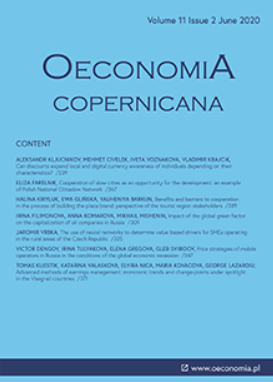Financial threat profiles of industrial enterprises in Poland
Financial threat profiles of industrial enterprises in Poland
Author(s): Jarosław Kaczmarek, Sergio Luis Náñez Alonso, Andrzej Sokołowski, Kamil Fijorek, Sabina DenkowskaSubject(s): Supranational / Global Economy, Business Economy / Management, Micro-Economics, Economic history, Transformation Period (1990 - 2010), Present Times (2010 - today)
Published by: Instytut Badań Gospodarczych
Keywords: financial threat; bankruptcy; early warning systems; risk management; enterprise crisis;
Summary/Abstract: Research background: The nature of bankruptcy has been the subject of interest for economic theories, both positive–identifying relationships between bankruptcy and other economic categories — and normative, shaping the rules for the proper regulation of bankruptcy. In turn, the functioning of an enterprise in conditions of risk, financial threat, and finally a crisis that could lead to bankruptcy, are of interest to management. The interpenetration of these two dimensions provided the motivation for this study, which assumes a bottom-up approach: from individual results to summarised multi-sectional comparisons. Purpose of the article: The purpose of the research was to evaluate the level, directions of change, and structure of the degree of financial threat in industrial enterprises. The period under analysis was 2007–2018 and the whole population of industrial enterprises in Poland (15,999 entities) was examined. The enterprises were small and medium-sized enterprises (SMEs) as well as large enterprises (LEs). The financial analysis covered macro-, meso-, and microeconomic levels. Methods: The analysis was conducted using a comparative approach and financial threat predictions obtained from the original multivariable logit model. Heat maps were used to evaluate the intensity of changes in financial threat. The displacement of objects in structures was studied, ordered, and classified. Four normative standards of threat scenarios were defined and then used to evaluate similarities in the profiles of the structures examined, using the similarity measure. The ranking and its variability were analysed in the assessment of profiles. Findings & value added: As the result of the research, properties were described and profiles were determined for the structures in terms of the degree of threat and its correlation with rate of bankruptcy and creating added value. The originality of the research comes from the use of novel dynamic logit models. The added value is a unique study on the entire population of industrial enterprises in the national economy and a methodology for identifying financial threat profiles and their similarity at subsequent aggregation levels (the micro-, meso-, and macro-levels).
Journal: Oeconomia Copernicana
- Issue Year: 12/2021
- Issue No: 2
- Page Range: 463-498
- Page Count: 36
- Language: English

